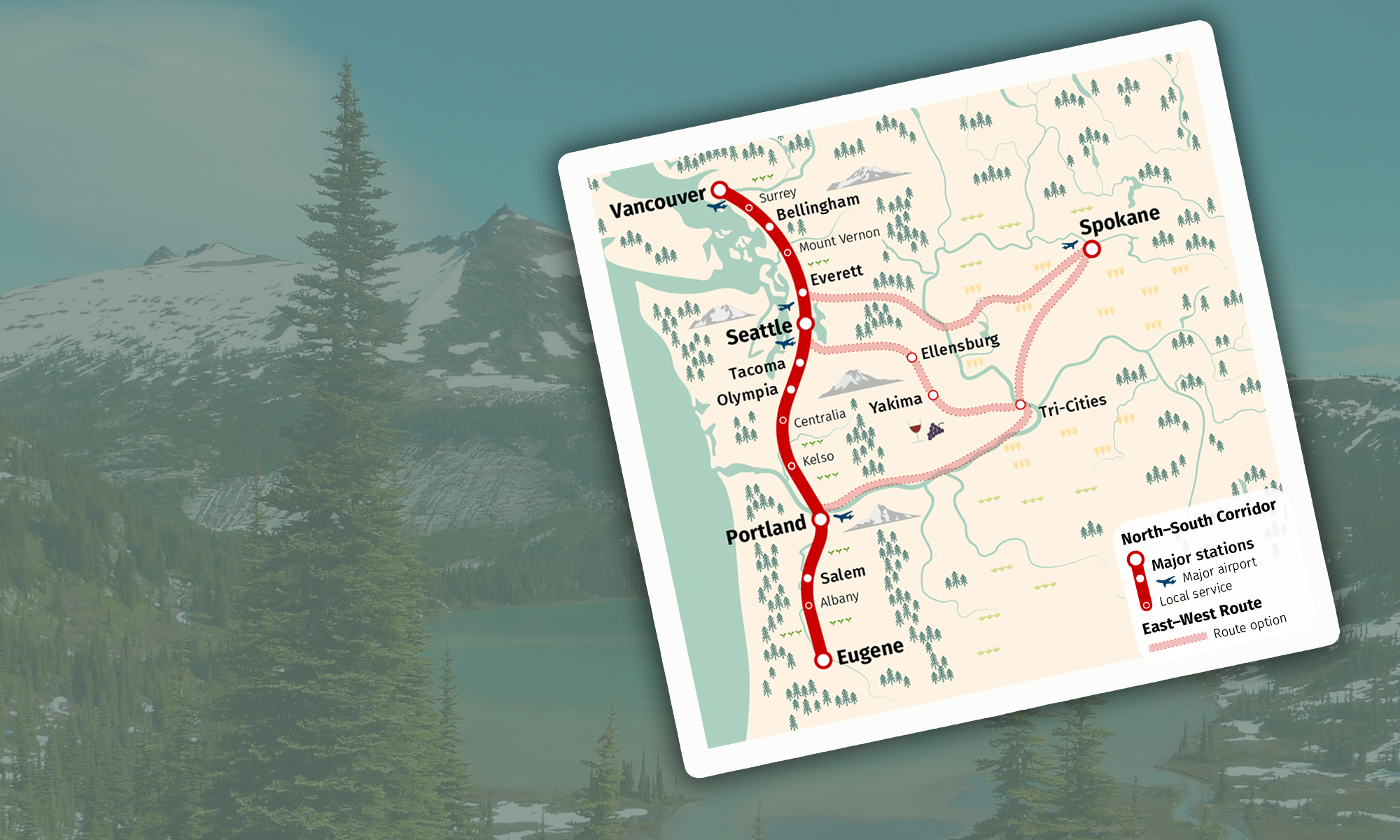Want fast trains for one hour trips between Seattle, Portland, and Vancouver, BC?
Founded in 2018, Cascadia Rail is a new organization of advocates spanning from Washington, Oregon, and British Columbia who support Governor Inslee & Premier Horgan’s efforts to connect the Cascadia region through high speed rail.
Our Vision
Cascadia Rail is advocating for a system that starts with the passenger. That means removing barriers to use, getting the most people out of cars. We want it to be a convenient and easy choice, so that people choose to use fast trains instead of driving or flying.
What that looks like:
- Station locations in downtowns, airports, and employment centers, where the most people will use them
- Station locations that connect with a city’s existing bus/rail network
- Ticket prices that are affordable for the most people
- A project build timeline to meet our climate goals of 2030
This is why we believe in it:
- It’s good for workers and quality of life. Short commutes are more than a luxury; they’re critical for reduction in income inequality. High-speed rail can reduce a 90 minute commute to 15 minutes. That’s extra time each day you can spend with your family or on your favorite activity.
- It’s good for business. The world economy is driven by global cities. Home to thirteen Fortune 500 companies, the Cascadia Innovation Corridor is expanding in-demand jobs, which can be made accessible by reducing the effective distance between our cities.
- It’s good for tourism. Seattle’s 39 million, Vancouver, BC’s 9 million, and Portland’s 9 million annual visitors spend $4 to $7 billion per metropolitan area and generates an abundance of local tax revenue. Fast, easy connections help more people see more places including wine country, Spokane, and all the iconic small towns in between.
- It’s good for economic development. Disproportionate economic growth is occurring in our largest cities. By making fast, convenient, and reliable connections between more places, all of our cities become increasingly attractive for commercial and residential urban growth.
- It keeps our great places great. Cascadia is an amazing place. We should experience more of it while spoiling it less with long car trips and congested roads.
How Fast Trains Transform Commutes:
Did you know Seattle is the third largest city in the country where people waste 3 hours or more each day commuting? According to WSDOT, a one way commute between Seattle and Tacoma/Everett takes 90 minutes; that’s triple the time a 30-mile journey should take due to traffic.
Seattle has the third largest population of mega-commuters in the country. A mega-commuter has a one way commute to work that is 90 minutes or longer. In the past 5 years, the number of mega-commuters has grown 72%, according to the US Census. More than 50,000 people commuting between Seattle, Tacoma, and Bellevue have a journey of 90 minutes or more.
In one year, an individual can spend 780 hours commuting by car — that’s 33 days — of your time each year sitting in traffic. High speed rail would connect Seattle to Tacoma/Everett in 15 minutes — a total of 130 hours or 6 days each year commuting. With high speed rail, you gain 27 days of your life back. What would you do with an extra month of time?
Fast Trains Create Jobs:
In the Pacific Northwest, 200,000 jobs will be created with the Cascadia High Speed Rail project. In addition to skilled labor needed for construction, operations, and maintenance, transit-oriented development will bring employment opportunities in other sectors. For every direct job in the railway supply sector, 4.2 jobs are supported in other industries, which would create positions for another 840,000 people.
Additionally, 212 companies in 32 states manufacture passenger rail cars or components creating many jobs in communities where rail construction would not occur.

Fast Trains Generate Economic Growth
The Cascadia High Speed Rail project is estimated to have an 8:1 ROI, bringing $355 billion in economic growth for a construction cost of $24-42 billion. In comparison, the cost to add one lane of highway in each direction on I-5 would cost $108 billion, take just as long to build, and the lanes would be full of traffic by the time it opened.
“Highway expansion cannot and will not keep up with growth, but we can make investments that can be gamechangers, like high-speed rail.”
Roger Millar, WSDOT Secretary — 2019 USHSR Cascadia Rail Summit
Business leaders agree: fast trains are a smart investment. Microsoft has shown continued support by pitching in nearly $600,000 to complete feasibility studies for the high speed rail project led by WSDOT.
Fast Trains Save The Environment
Transportation is the biggest source of pollution in the Pacific Northwest, with over 60% of emissions coming from driving and flying. Globally, when a high speed rail line opens, it absorbs 50% of the air travel market and reduces cars on the road by 40%. By giving people a new choice of mode, we can move people from carbon-intensive transport to sustainable, electric trains. The Cascadia project would reduce carbon emissions by 6 million metric tons.

